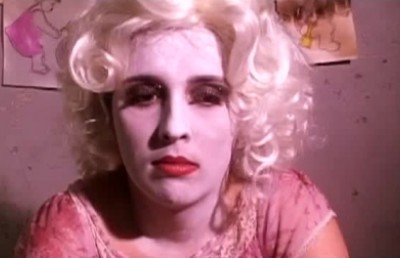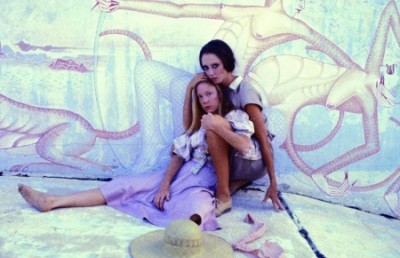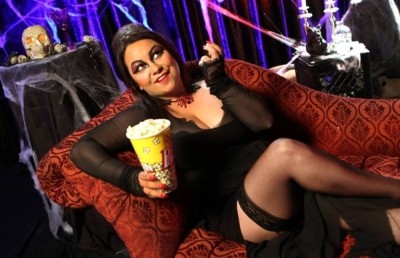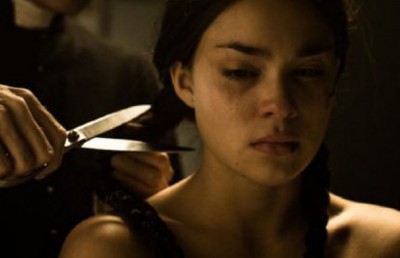When Women Kill: Recent North American Horror Films
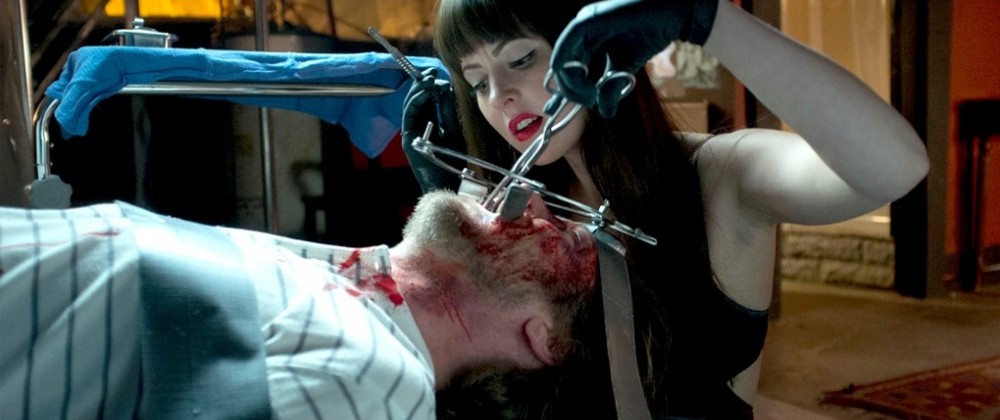
“My intention is not to disgust the spectators, but to make them part of a wholesale slaughter. I find it pretty kinky that the story is about a woman killing men”
Alain Robak [Diabolique, p. 59]
The above quote is from the director of the cult French horror film Baby Blood, a film which sees a young attractive women named Yanka (Emmanuelle Escourrou) impregnated by an alien slug which induces the woman to murder to satiate the alien’s thirst for blood. The alien, who eventually leaves her body, seems to want to learn everything it can about what it is to be a woman, a gesture which reflects the director’s own aim to “understand Yanka and the intricacies of the female experience” (Gibert, P. 58). Baby Blood was one of many European horror films I referenced in my January 2002 Offscreen essay “The Final Girl: A Few Thoughts on Feminism and Horror” which argued that from a gender dynamic perspective, North American horror films were far less adventurous and less progressive than Euro-horror films, even Euro-horror from an earlier generation. Women in Euro-horror films from the 1960s onwards were given more active roles, which in the horror genre often meant being antagonists, and killers. Comparatively, women who kill were a rare breed in North American horror films. However, something wicked has happened in the last decade plus in the landscape of North American horror: the female as antagonist and potential killer has caught up to its older European counterpart. Since my essay in 2002 there have been dozens of North American horror films featuring powerful lead roles for women who, for a variety of reasons, kill. Indeed, “the intricacies of the female experience” have evolved into slightly uncharted territory for North American horror films since the mid-2000s. Female killers as monsters (zombies, vampires, werewolves, etc.) have remained a fairly constant presence in horror films over decades, but the difference now is that women are killers in a more realist context as well, as serial killers and psychopaths. What has happened to make this difference? This increase in female killers is not a reflection of reality, since the majority of real serial killers remain predominantly male. In this essay, which can be seen as a follow-up to the 2002 essay [which remains one of my most frequently cited Offscreen essays], I will survey this changed landscape in North American horror, where women are now just as likely to be killers as men, analyzing some key films/filmmakers and offering some possible reasons (social, cultural, industrial) for why roles for women in horror has changed (for the better I will suggest) so dramatically.
In my 2002 essay I acknowledge the important work of scholar Carol Clover (Men, Women, and Chainsaws: Gender in the Modern Horror Film) in recuperating and carving out a space for female spectatorship and feminine identity in horror. But Carol and others who rely almost exclusively on American horror end up being forced to rely, theoretically, on Freudian or post-Freudian (i.e. patriarchal) models, where the women is either a victim, or if able to turn the tables on the monster/killer, loses her ‘femininity’ by becoming a masculinized female. To once again quote (from my earlier essay) Cristina Pinedo, “If a woman cannot be aggressive and still be a woman, then female agency is a pipe dream. But if the surviving female can be aggressive and be really a woman, then she subverts this binary notion of gender that buttresses male dominance.” While missing in earlier American horror, the women who kill while retaining their sexuality/femininity has been common across many European horror films since the 1960s (including the close cousin to horror, the Italian giallo).
If a female killer maintaining her sexuality is a key ingredient to setting things right, then there may be no better place to start my survey of recent North American horror films than All the Boys Love Mandy Lane (2006, Jonathan Levine), a film I have written about elsewhere on Offscreen, and which has had a tough time getting any kind of proper distribution. Lane is a key film partly because it has a strong Euro sensibility in its depiction of gender and horror. Mandy Lane (played by a pre-major weight loss Amber Heard) is a character idolized by Levine’s camera and characters, male and female. She is the archetypical ideal of the unattainable female, a Goddess in her perfection: athletic, intelligent, and slightly aloof. The high school setting establishes her as the school Queen, but with no one around worthy of being her King. All the males at her school fantasize being with her, including gangly introvert Emmet (Michael Welch) who is ostracized by the school’s elite. The film’s visual style accentuates its digital origins, with a highly saturated, high contrast color palette, a roving camera and a contemporary score. One skinny dipping scene frames Lane undressing against a bright orange sunlight that frames her in a golden halo. The bulk of the film takes place at an isolated cabin, where the boys and girls drink, party, have sex and engage in frank talk of sexual insecurities that we rarely find in slasher films. But as this is a slasher film, the characters begin to die one by one as they isolate themselves from the group and fall prey to a killer lurking outside the desolate cabin grounds. Well before the end the killer is revealed as Emmet, angry over his alienation from the crowd. But the real twist comes in the final act, when it is revealed that Emmet is working in tandem with Mandy Lane, in a premeditated “Romeo and Juliet” murder/suicide pact. The revelation of a male/female killer team recalls the first great giallo by Mario Bava, Blood and Black Lace, and other Euro horror films that feature female (or joint male/female) killers. But Mandy Lane has other designs, and deceives Emmet, kills him and drives off with an older man who is unaware of Mandy Lane’s true nature. Her character is a stealth version of Pinedo’s claim that real gender gains in horror can only be achieved when a woman can be aggressive and remain every bit a woman (and not a masculinized female, as in many earlier slasher/stalker films, or films where the woman is crazy because of her sexuality, lesbian or straight, a criticism which can be leveled against Haute Tension).
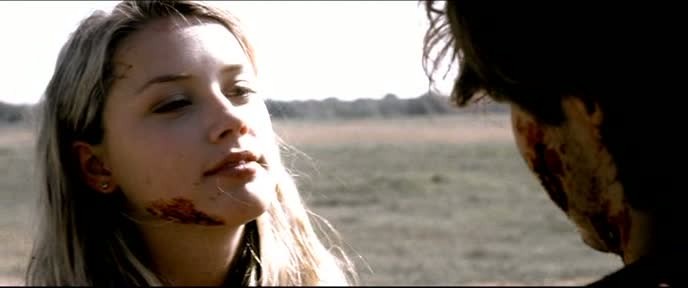
All the Boys Love Mandy Lane
Another recent female character who does not shirk from her obvious sexuality, using it as a form of empowerment, is Mary Mason from American Mary (2012), directed by Canadian identical twin sisters Jennifer and Sylvia Soska. The Soska sisters have already made their mark on the horror scene with three feature films to date, Dead Hooker in a Trunk (2008), American Mary (2012), See No Evil 2 (2014), and the segment “T is for Torture” from The ABCs of Death 2 (2014). In American Mary they team up with Katharine Isabelle –who nailed the theme of monstrous violence as a metaphor for sexual empowerment with her character of Ginger in Ginger Snaps, 2000– in a medical-themed horror film which treats sexism in the workforce, in this case the medical profession. To help pay her way through med school Mary enters the illegal world of extreme body surgery and body modification. Alienated from her peers and mentors in the medical field, Mary slowly enters the underground body modification community, with the Sosta sisters careful to humanize these social outcasts. Mary’s professor (David Lovgren) leads her to believe that she has a bright future in surgery, and invites her to a private party where she can meet the cream of the medical profession. Instead she is drugged and raped by her professor. Mary gets her revenge by kidnapping, torturing and ‘experimenting’ with her rapist professor (perhaps a response to Cronenberg’s gynecological nightmare film, Dead Ringers, 1986). When a security guard tries to save the professor, Mary viciously clubs him to death. Sensing her career in conventional medicine is off the cards, she goes full throttle into body modification surgery. Mary is in the end killed by the jealous boyfriend of a client. As Jon Towlson notes in his reading of American Mary in his excellent book Subversive Horror Cinema (p. 206-210), Mary’s failure to achieve the proverbial ‘American dream’ leads her into the descent into the underground to be able to perform her ‘art’; this path can be read figuratively as the Sosta’s sisters own well documented trials and tribulations in trying to make films in a male dominated industry and how they found solace and support amongst the ‘freaks’ populating the underground horror community, like Mary Mason finding kinship among the ‘freaks’ in the body modification community.
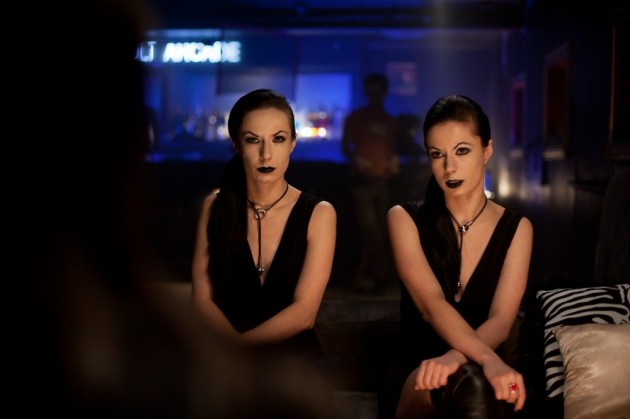
The Sosta sisters
Loosely tied to the medical-themed female-centric horror are films featuring destructive sexual parts. The prototype (riffing on Cronenberg’s Rabid) is the endearing feminist high school teen horror Teeth (2007), which literalizes man’s castration fear by ‘endowing’ wanna-stay virgin Dawn (Jess Weixler) a vagina dentata primed to rip off unwanted intruders. Like American Mary, Dawn’s trigger for violence is a forced sexual encounter by a schoolmate who has a crush on Dawn; in an early scene Dawn visits a hapless gynecologist who confirms her ‘vagina dentata’ (at the expense of his fingers). Women ‘biting’ off male fingers is a motif across several recent horror films, occurring in McKee’s Woman and A Girl Walks Home Alone at Night. Frank Henenlotter’s Bad Biology features matching killing private parts, a vagina with seven clitorises and an abnormally large (and insatiable) penis. Both inflicted characters have supercharged sex drives that literally devour their sex partners. The fate of the two characters, Batz (Anthony Sneed) and Jennifer (Charlee Danielson), are kept separate until they meet in the final act. Another film with similar malfunctioning sexual parts is one brought to my attention by Kier-La Janisse in her marvelous book The House of Psychotic Women (a must read for anyone interesting in issues of gender, psychosis and horror), The Secret Life of Sarah Sheldon (2006, Annette Ashlie Slomka, Joseph Dodge). The film stars its female co-director and writer Ashlie Slomka in the titular role of (another) failed med student who surgically attaches a large penis designed to “disable a woman’s ovaries during intercourse as a means of sterilization” (Janisse, p. 317). Such medical ideals are wont to go wrong, and this one follows suit, as the unnatural penis causes death by internal hemorrhaging. Things take an even more bizarre twist in one of the most literal and absurd takes on ‘penis envy’. Since I have yet to see the film (but am diligently trying to track it down!), I’ll leave it to Janisse to describe the absurdity:
After trying it [the organic, prosthetic penis] out on her naïve girlfriend, she cuts her hair (symbolic transformative act) and tracks down the guy that beat her so that she can rape him with her giant toothed dick (p. 317).
In Subversive Horror Cinema Jon Towlson argues that such recent feminist horror films as Teeth and American Mary are a direct challenge to Bush’s conservative social policies, including his 2006 “abstinence-only” education incentives. He correctly describes Dawn’s journey in Teeth as one from “sexual repression to sexual empowerment” (198-199); and concludes, “The new feminist horror of Teeth and American Mary can be seen as a direct challenge to these social policies that were part and parcel of the Bush era” (p. 198).
One of the most important contemporary American horror directors when it comes to strong female characters is Lucky McKee; so much so that I feel compelled to label him the “George Cukor” of contemporary horror directors. In each of his films, from his first film May, a feminist twist on Frankenstein, introducing his muse Angela Bettis, to his entry in the Masters of Horror TV show, the odd couple love story Sick Girl, to the Suspiria_-influenced _The Woods, to his latest boil over of the teen comedy and zombie film All Cheerleaders Die (2013), McKee writes great female characters, sometimes (it must be said) to the detriment of his male characters, who are either inconsequential or foils for his female characters.
In All Cheerleaders Die the focus is on the rivalries, petty and serious, among a group of high school cheerleaders. The core of the drama cuts through two leads, Maddy (Caitlin Stasey) and lesbian Wicca Leena (Sianoa Smit-McPhee), who becomes upset when Maddy drops her for a cheerleader diva, who tragically dies in a cheerleader training routine. Maddy, who secretly resents the cheerleaders, feigns her way into the cheerleader group (or “bitches’ as they refer to themselves). Maddy turns her attention to popular blonde Tracey (Brooke Butler), stealing her from her narcissistic super jock quarterback Terry (Tom Williamson). Terry’s manhood is challenged when he catches Tracy and Maddy together, which riles the jealous anger of both Terry and Wicca lesbian Leena. The highpoint of the film’s insurgency comes 30 minutes in when Tracey goes toe to toe with her insulting ex-boyfriend super jock Terry, whose only recourse to being verbally outdueled is to punch Tracey in the face. This altercation builds to a high speed car chase, which leads the car with the four cheerleaders careening off the road into a river. The boys do nothing to help the girls out of the car, running from the scene of the crime. The four girls drown to their death….but only for so long. Leena uses her black magic color beads to cast a spell that brings them back to live. But rather than return as putrefying zombies (the word is never uttered, perhaps for fear of the film being erroneously lumped in with the recent zombie craze), the cheerleaders, apart from a few temporary body imperfections, retain their physical beauty, and use it to usurp the male, testosterone hierarchy at school.
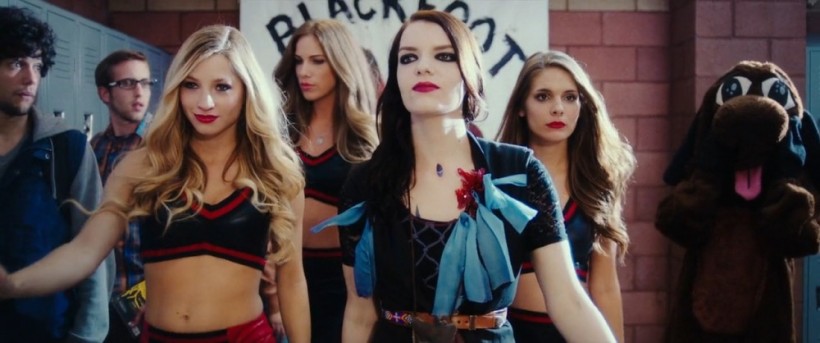
All Cheerleaders Die
When it comes to female empowerment, Mckee’s masterpiece is The Woman (2011). McKee’s appropriately titled The Woman is a meta-horror film if there ever was one, stripping down the primal gender elements of horror to its skeletal bareness: patriarchy is REALLY bad and finally meets its match in the form of a feral thirty something tigress raised by wolves who bides her time until meting out payback for every sin committed against the female gender by man. I may be exaggerated things somewhat. There is a plot here: a successful family man, Chris Cleek (played with just the right amount of nonchalant passive aggressive menace by Sean Bridges) lords over his family with Old Testament vigor. Man is might and might as was well rule, seems to be his motto. While out hunting one day he spots the feral Woman (played with impressive gusto by Pollyanna McIntosh) taking a bath in the river. The sight of a savage woman primed to be civilized is too great a temptation. He later returns to the woods prepared, knocks her out while she is off guard and carries her off into his basement. What ensues is a perverse version of the Pygmalion story via Jack Ketchum, whose previous adapted story The Girl Next Door has many parallels to The Woman, with a bad mother replacing the bad father as the torture ringmaster. The Woman is kept tied up in the basement, her arms outstretched Christ like…but she is anything but a Christ symbol. Chris’ wife Belle Cleek, played with appropriate skittishness by Mckee regular Angela Bettis, quivers in his presence. She holds back her true feelings, knowing full well that expression of them will lead to quick and severe repercussions, as happens later when she threatens to leave him and he beats her to near death. Teenage daughter Peggy Cleek disapproves of her father’s iron rule, but is too subservient to do anything about it (Peggy Cleek is played by Lauren Ashley Carter, who also stars opposite Bridges in the Mckee produced Jug Face, another female-centered horror film, with a progressive representation of the rural backwoods horror subgenre). The youngest daughter Darlin’ (Shyla Molhusen) appears stunted in her growth; and the only son, the adolescent Brian (Zach Rand) is itching to follow his dad’s footsteps. Chris tells his family that his aim is to “civilize” her, with the weak justification that it would not be safe to leave such a dangerous creature roaming their nearby grounds. And dangerous she is. Her first violent act is to bite off one of Chris’ fingers –symbolically she spits out his wedding ring. While dirty and surly, there is no doubt that Chris’ attraction is largely sexual. And, interestingly with respect Pinedo’s earlier comment, the Woman is aggressive but maintains her ‘femininity’ through her ability to seduce both father and son.
The Woman builds in a contrived fashion to the bloody conclusion, with the father figure Chris Cleek being so despicable that we assume anything he’s got coming is justified. But this is probably McKee’s point, because when the Woman lets out the full wrath of her violent fury killing, in sequence, the wife, the son, and father –ripping out and eating the father’s heart right in front of his eyes, like an ancient war lord symbolically eating his rival’s heart as a sign of power transfer– even the most ardent of gore hounds will be crying uncle. It is important to note that the Woman’s fury seems equally vented at the women who allow themselves to be dominated by men. McKee suggests a new world order when the Woman leaves for the forest with her new family in tow, her –we assume– mutilated offspring, who was kept as a hidden hostage by the family and revealed in a twist ending, and the youngest daughter of the Creek family, Darlin’. The teen daughter Peggy, who The Woman also lets live, first hesitates to join but then begins to walk toward them. Peggy is in the mold of the socially awkward, alienated female teenager whose neurosis leads her to murder, set forth by her co-star Angela Bettis in Mckee’s May, Pauline (AnnaLynne McCord) in Excision, Lola (Robin McLeavy) in _The Loved Ones (2009), and Lily (Anne Paul) in Roman’s Bride (2010, Michael Paul). Although Peggy has not killed yet, murder seems to be in her future.
An earlier film with a similar premise that makes an interesting companion piece to The Woman is Deadgirl (2008, Marcel Sarmiento, Gadi Harel), which sees a feral woman (in this case an undead) tied up and used as a sex toy by a group of male teenagers. The ‘deadgirl’ breaks free at the end and kills three of her rapists before escaping into the night. Rather than closure, she is replaced by another ‘deadgirl’ to form a cycle of male abuse. Yet while Deadgirl does not pack the same cathartic use of femme violence as The Woman, in some respects its critique of patriarchy is as potent, if not more so; largely because Deadgirl offers the viewers a male character it can identify with but then sucker punches us with its resolution. Two male teenagers Rickie (Shiloh Fernandez) and JT (Noah Segan) come across a beautiful nude woman (played by Jenny Spain) lying chained on a slab in the basement of an abandoned former mental asylum. They have no idea who she is or how she came into this predicament (and the film never offers any answers). She is alive but does not speak, instead growls like an animal. The woman represents an exaggerated male teen wish fulfillment; her status as a ‘deadgirl’ also functions figuratively as the state many women eventually become in conventional horror films. Rickie feels pain for the woman and wants to free her. JT has other plans, seeing this situation as an opportunity for free sex. When JT discovers that the captive woman cannot be killed, but is in a state of ‘undead,’ this changes the stakes, adding ‘S & M’ and violence to the equation. JT and a third friend Wheeler (Eric Podnar) physically abuse and rape the woman, while Rickie resists the temptation, which makes him a point of identification for the audience. Rickie and JT are best friends, but Rickie does not approve of JT’s treatment of the chained woman, although his resolve does not go as far as confronting JT directly. Rickie is clearly not as ‘bad’ a male as Wheeler and JT or the father and son in The Woman. Like The Woman, Deadgirl depicts the ugly, dark side of the male, presenting shocking images of rape and male violence.
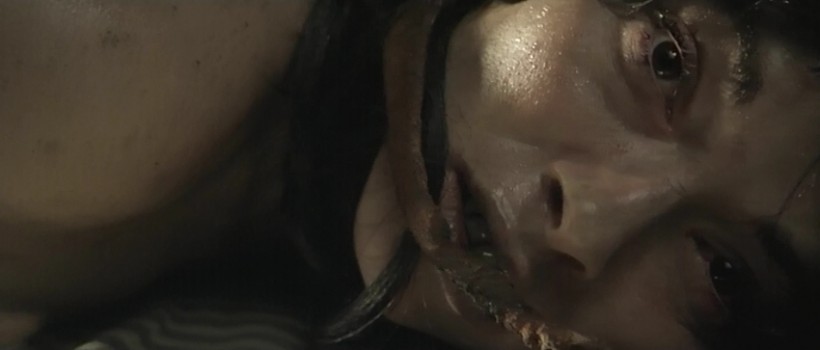
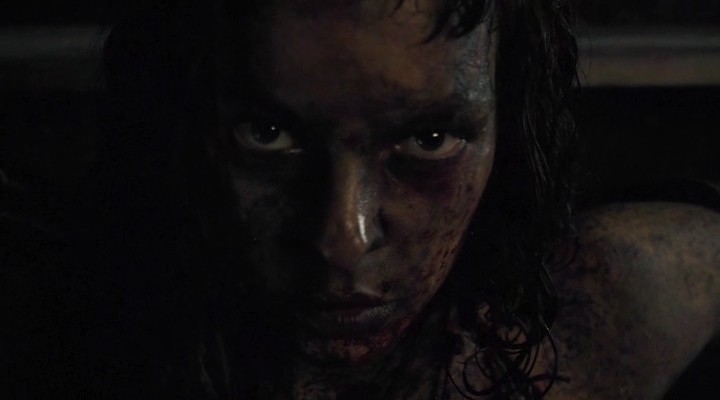
Feral women in Deadgirl and The Woman
While JT lusts over the ‘deadgirl’, Rickie fantasizes over his childhood sweetheart Joann (Candice Accola), who dates school jock Johnny (Andrew DiPalma). In a funny inversion scene which features femme power in a realist context, JT and Wheeler decide to add a second woman to their sexual playpen and stake-out a gas station for a victim they can kill and bring back to the asylum basement (something in the room seems to reanimate corpses). They hone in on a thirty-something woman in cut-off jeans and a bra. They lure her to the car. As the woman bends to look at something in the trunk Wheeler hits her over the head with a crowbar. She turns. Blood begins to trickle down her forehead. JT and Wheeler look stunned to see her still standing (maybe the point here is that, try as you may, women just don’t die in this film!). She proceeds to beat them up, leaving the two sorry teens writhing in pain on the floor as she walks away and gives them a backward finger and salutes them, “Bitches….fuck you!” A few moments later a victim falls in their lap, as Joann comes banging on their hood asking them, “What the fuck did you do to my boyfriend?” On the premise of bringing her to meet her boyfriend, they take Joann back to the basement, where she is gagged and tied, primed to be ‘deadgirl’ sex toy #2. As they argue, the Deadgirl frees herself and attacks her tormentors, fatally wounding Wheeler and JT, while sparing Rickie. Like The Woman, the Deadgirl might be vicious and feral, but has a moral compass, attacking only who she feels deserves her justice (like the vampire in A Girl Walks Home Alone at Night, discussed below). Rickie is too late to save Joann, who bleeds to death in his arms from a stab wound inflicted by JT. The scene slowly fades to black, but with loose ends that set up the twist ending.
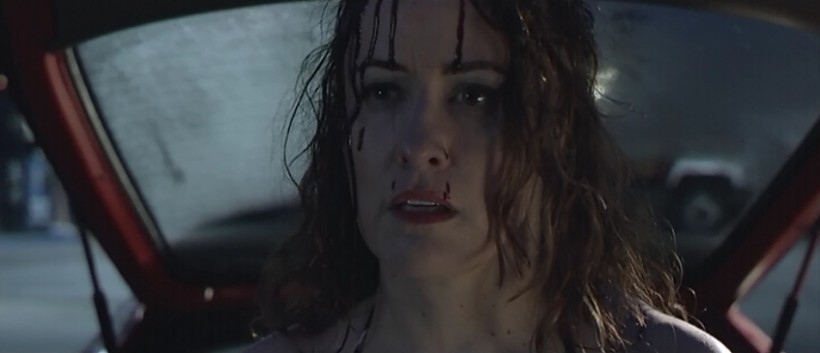
This girl is too tough for our male heroes
The film concludes the violent confrontation in the basement with two wonderfully evocative edits: a slow fade to black and then back in to a slow motion night shot of the Deadgirl running off into the woods (never to be seen again) and then cutting straight to a close-up of Rickie in class, asleep at his desk (has he been dreaming all this?). Rickie seems to have returned to his previous life without any apparent ill effects or trauma. A brief montage features him relaxed, smiling, walking home, content with himself. But the montage slowly dissolves to a series of hand-held POV tracking shots that return us to the asylum basement, eventually settling on a close-up of the new ‘deadgirl’, Joann lying on the slab. Her eyes are at first shut, then spontaneously open wide, remaining unnaturally blank and unblinking. Was killing Joann JT’s dying favor for his friend, knowing that she would be reanimated? The film finally fades to black. Rickie’s presence is never revealed, but is implied through the subjective POV shots. The implication of this final scene is that Rickie will now be able to consummate the love he could have never fulfilled in the real world. In the end the male character we have strongly identified with as having some moral compass, ends up being no better than the others.
Tapping into the barrage of recent viral epidemic films is Maude Michaud’s debut feature, Dys- (2014), an intense Kammerspiel horror that is a mix of In My Skin and Possession. Dys relies entirely on the interpersonal dynamics of a married couple contained in their apartment by public quarantine order while their marriage slowly crumbles from indifference, neglect, depression and social dissociation. Eva (Shannon Lark) and Sam (Alex Goldrich) are thirty something professionals who have reached an impasse in their relationship, something made more pungent by the forced containment. Recalling Antonioni’s female character from Red Desert, Eva is suffering from a traumatic experience which has made it hard for her to readjust to society. Writer/director/producer Michaud structures the narrative so that the traumatic event is literally ‘sutured’ into the narrative in fragments, flashbacks to happier times (courtship, sex, news of pregnancy) leading up to the ‘event’: a bloody ‘old school’ (coat hanger) self administered abortion. The real reason for why Eva decides on the abortion is left open ended, which makes the film thematically stronger. Echoing the growing tension and violence within their relationship is the epidemic outside, which causes people to turn violent and potentially ravenous murderers. Eva keeps the tiny aborted fetus pickled in a mason jar, as both a reminder of her act but a comfort blanket to her guilt. When Sam, who was led to believe Eva had a miscarriage while he was away on a work trip, finds the jar he loses control and seeks revenge for the act of mistrust by tying and torturing Eva. For a short spell the film slithers down to a hostage-torture film, but only long enough for Eva to set herself free and stab Sam with the same coat hanger she used to abort her fetus. She then takes a wooden plank used to barricade the front door and smashes Sam’s face repeatedly with the nail side out (an act of violence which recalls a similar attack in Haute tension). Eva’s use of force harbors anger and resentment, which we sense when she breathes several sighs of relief after killing Sam. Dys- is marked by an element common to many of these contemporary female-centered women that kill films: a lack of any moral retribution against the female killers. After the murder of Sam, Sam’s friend and neighbor James enters the apartment. He has blood over his body, suggesting he is inflicted by the viral epidemic. Eva looks at him seductively, removes her shirt and orders James, “make me a baby.” He appears ready to oblige, and the film ends on a cut to black.
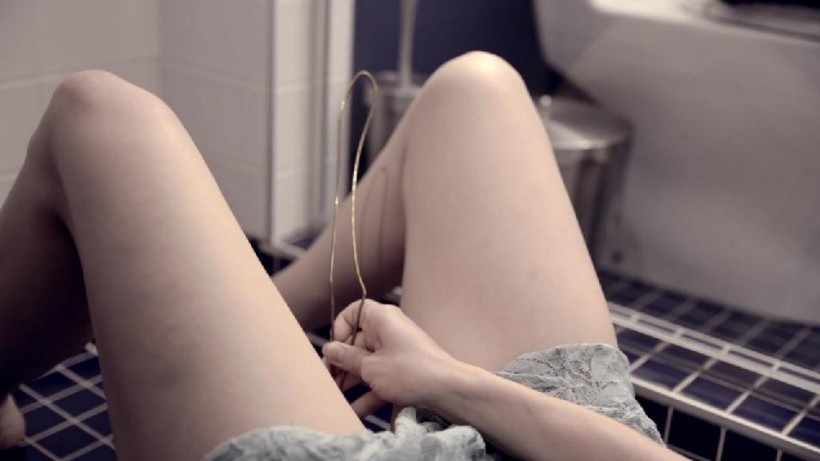
Another Montreal-based filmmaker who directed a female-centric horror film with a female who kills is Éric Falardeau and his female body horror Thanatamorphose (2012). The title derives from the Greek word for body decomposition caused by death, and that pretty much describes the film’s action arc. In both Montreal films the body count is low (all victims are male) and they are both set in a singular setting –an apartment. Thanatamorphose deals with a young female sculptor (Kayden Rose) who spends an evening with her boyfriend and then slowly begins to decompose, not unlike Jeff Goldblum’s/Cronenberg’s Brundlefly, until being reduced to a quivering mass of skin, blood and bones. The film’s style, punctuated by experimental reverse negative imagery, static color patterns and abrasive sound cacophonies, downplays the violence and make-up (which is outstanding) set pieces by low key lighting and quick edits. Like in Dys-, the female character is emotionally withdrawn, unable to perform normal social engagement and the murders she commits are more an expression of inner torment than an act of violence. The victims are men, the symbolic target for her depression, and the violence is at once sexualized but also suggestive of an imaginary state (they may be murder fantasies as much as real murders).
A more straight forward or literal rather than figurative version of Thanatamorphose is the US indie horror film Contracted (2013, Eric England), which stars Najarra Townsend as a young woman, Samantha, who begins to experience a similar body horror meltdown after a one night stand. Her symptoms –some of which clearly target a female spectator –bad abdominal cramps, heavy vaginal bleeding, vaginal rash– go beyond any known sexually transmitted disease: blood shot eyes, hair loss, teeth falling out. Although sex=death suggests an old school stalker film morality, Contracted is something else entirely, and the real reason for her deteriorating physical condition is never clearly stated. This recalls Nina Sayers (Natalie Portman) in Aronofsky’s Black Swan, who also begins to manifest, real or imagined, body sores and increasing body decay as her inner stress over her insecurities about her ability to perform the dual roles of Black Swan increases. In Contracted Samantha’s physical problems do begin after unprotected sex with a stranger (who it is implied by the pre-credit scene may be a necrophile), but the link, while probable, is never definitively stated within the narrative.
The real culprit of the film in terms of causes just might be unrequited love; or the powerfully negative karma of “unlove” or ‘nonlove’. In every case where there is a form of potential love between humans, there is anti-love, or hatred, suspicion, animosity or jealousy. Samantha, a recently turned lesbian, is at the center of a series of unrequited pairings. Samantha’s mother, a religious zealot who hasn’t taken kindly to her daughter’s turn to lesbianism, cares for Samantha’s well being but with a heavy air of condescension and resentment. While Samantha is always curt and abrupt, if not outright dismissive, of her mother. Samantha is madly in love with her new lesbian lover Nikki (Katie Stegeman), who in turn treats Samantha like a flavor of the month and drops hint after hint that she is no longer interested in Samantha. Samantha’s best friend Alice (Alice MacDonald) is attracted to Samantha, but is continually rebuffed by Samantha who remains aloof and distant to her. While Samantha’s former boyfriend Riley (Matt Mercer) masochistically clings after Samantha, who treats him with disdain.
Of the many recent ‘women that kill’ films none is more brazen than Neighbor (2009, Robert A. Masciantonio), which features an attractive, athletic, young woman, hiding her socio-pathology in plain sight, terrorizing an upper class suburban neighborhood by simply entering houses by day and torturing and killing the inhabitants. In my Fantasia report of 2009 I wrote at length about this film, noting:
What makes the behavior in Neighbor especially disarming is that we are never even shown how the woman ‘breaks’ into these homes. Or the details of how some of her victims get from point A (innocent) to point B (victim tied in a chair). She also does not seem to care much about covering up her crimes and leaves each home as if nothing has been touched. In the finale scene when we see her walking away freely dressed in black from head to foot, with nary a moral stance offered by the text, the idea flashes our head: is she a modern incarnation of the devil? Death itself? Or evil personified?
What sets Neighbor apart from the slew of recent torture-horror films is that the perpetrator is female. It may seem that director Masciantonio has made his villain a woman for no other reason than the novelty and shock of having a female killer, but it also serves the story. As a woman, potential victims let their guard down or put themselves in a vulnerable position because they don’t harbor (consciously or unconsciously) any fears toward a woman and hence do not see her as a potential risk or threat. Director Masciantonio plays his audience like a violin, performing a perfect slip from the killer’s relentless sadism, to the psychological effects of her kidnapping and torture on the traumatised victim, and then back to the killer’s gut wrenching violence. Masciantonio even gives us a scene of the Girl taking a shower to wash off the blood, which plays on the typical scene of the victim who takes a shower to cleanse or purify herself (usually from a rape, attack, or a murder). But there is no such purification here.
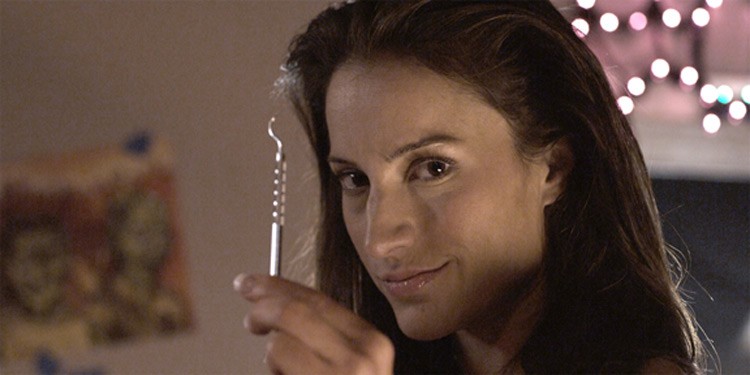
America Olivo as the disarming killer in Neighbor
Neighbor lays to rest the notion that a female serial killer cannot be as violently sadistic as a man. The Girl (as she is referred to in the credits, played by America Olivo) tortures her victims with a naïve Sunday girl charm. What’s also disconcerting is the lack of an apparent motive. There is a hint of class envy in the way she behaves in the well to do homes she breaks into, but nothing is stated or claimed with certainty. As humans we always strive for a ‘reason’ behind a vicious crime, believing that reason will add a measure of closure and safety. This is not anywhere to be found in Neighbor; and making the killer a woman just makes the lack of a reason more disturbing. More conventional examples of female-centered serial killer films include the rape revenge vehicles I Spit on Your Grave (2010) and I Spit on Your Grave 2 (2010, 2013, Steve R. Monroe) and the Canadian crime-exploitation film Sweet Karma (2009, Andrew Thomas Hunt) [reviewed here.
The increased presence of female antagonists, women who kill and women who fight back is so marked in the recent landscape of North American horror that some critics have defined this growth as a sub-genre, the female-centered horror film (C. Jerry Kutner, “American Mary (2012) and the Female-Centered Horror Film”). The films are not necessarily a homogeneous lot, but certain trends and patterns can be ironed out. For starters, one can distinguish between Female-centered horror (where lead character is female) and female-centric (where the themes are part of the female experience –pregnancy, abortion, date rape, sexism, chauvinism, sexual and work harassment, lesbianism). A good many are directed (or at least written by) women; some are directed by men but feature a strong female character as the central point of identification; or in some cases feature a predominantly female cast. The range of this women-who-kill renaissance includes not only gore-fests or more obvious horror fare but art horror as well, including the above Thanatamorphose and Ana Lily Amirpour’s nocturnal vampire dirge, A Girl Walks Home Alone at Night (2014). Night bears little resemblance to any recent horror films, but rather older films like Nadja, The Addiction, Erasherhead, and Blue Velvet. More than a passing resemblance can be made to Under the Skin, the 2014 science-fiction art film directed by Jonathan Glazer, also featuring an enigmatic, other-worldly taciturn female assassin, who quietly stalks her male victims (played by Scarlett Johanson). And Jim Jarmusch’s vampire take, Only Lovers Left Alive (2014).
Shot in a high contrast black and white, A Girl Walks Home Alone at Night takes place in a perennial night time in a post-industrial Iranian ghost town called ‘Bad City’ (filmed in the desert town of Taft, California). The creamy black and white cinematography and pumping oil derricks recalls Orson Welles’ A Touch of Evil. The female killer is a chador wearing, roller skating vampire, who says little and lets her expressive eyes and switchblade fangs do her talking. The vampire, simply named ‘the girl’ (Sheila Vand), when not killing out of hunger (a homeless man) seems to possess a moral compass, killing a bad drug dealer who intimidates the hero Arash (Arash Marandi) and his addicted father Hossein (Marshall Manesh) and then the father himself, after he aggresses a prostitute named Atti (Mozhan Marnò). She even terrorizes a young boy and warns him that if he wants to avoid meeting her in the future that he should be a “good boy.” This comical moment harbors a veiled critique against patriarchy: keep them honest when they are young! The film moves at a dreamy, hypnotic pace, underscored by DP Lyle Vincent’s gorgeous night landscapes, the oppressively grey landscape, the constantly billowing smoke, and an ambient Brian Eno-type musical motif that repeats rhythmically as if on repeat mode from beginning to end. The visual representation of the vampire is arresting, with her all-black chador acting as a camouflage against the dark background; she appears in extreme long shot as a dark spot along the desolate sidewalk; to then appear directly behind the victim through a straight edit.
The film is also a love story about two lonely souls, the girl and Arash, who is slowly wasting away caring after his drug addicted father, who has not recovered from the loss of his wife. Their platonic relationship recalls the budding love between the vampire girl and young boy in Let the Right One In. The girl’s murder of the father Hossein can be seen as part of her design to set him free (or as a way to trap him under her power). The hesitant ending, which frames the girl and Arash in the front seat of his Thunderbird, with his cat sitting between and behind them, offers a glimmer of hope, as they leave ‘bad city’ for a new start (again echoing the end of Let the Right One In).
Although the film I alluded to earlier, Under the Skin is normally categorized as an art film in science-fiction skin, it plays with horror film tropes as well, notably the slasher film. In this case the ‘killer’ is an alien or a pawn in the human form of Scarlett Johansson used by aliens to stalk, pick up, seduce, arouse and then lead men to their liquid death. The alien drives around the city of Glasgow in a white van stopping male strangers until she finds an appropriate one, usually single with no family ties. She leads the victim to her ‘apartment’ which then abruptly shifts into an all-black void. She leads them farther into the void, performing a strip tease act until the man is nude and fully erect. At this point she continues to walk on solid black while the man slowly slips into the black pool, eventually being reduced to a floating mass of skin as the innards are absorbed into a red-black sludge that is transported along a conveyer belt to (we can only guess) the alien home planet.
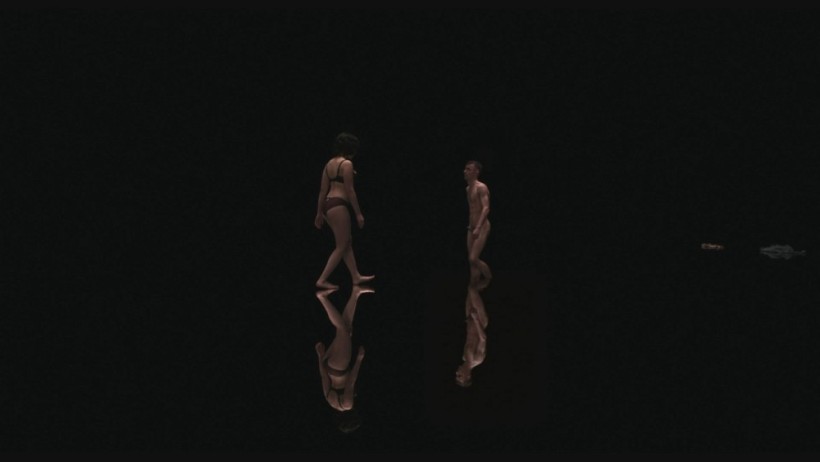
Under the Skin: The Black Pool of Male Desire
The female killer in this case is ALL about the female form as an object of male sexual desire, not unlike the Woman in McKee’s The Woman. It seems that once she becomes aware of this, or aware of having an identity other than a sexual seductress, she is unable to kill. This seems to occur after an encounter with another potential victim, a sad, lonely facially disfigured young man. Her talk with this man is more deeply personal than her usual discussion with her victims. Something about the ‘ugly’ man triggers an emotional short circuit which makes her more self-perceptive. She continues the seduction but has a change of heart and frees the man from the black pool and lets him escape, as the shocked nude man runs off into a green space outside the city perimeter. After this experience the Johansson character stops stalking (and talking) and begins to look at herself in mirrors; once charming and talkative in her seductive persona, she know remains mute and inexpressive. In her growing self-awareness she has become a threat to her motorbike riding alien male controllers (homage to Cocteau’s Orpheus?), who are now hunting her down. She attempts a ‘normal’ sexual encounter with a single forty-something man, but is disturbed or puzzled by the actual act of intercourse (in the film’s funniest moment, she breaks away during intercourse and sits on the edge of the bed examining her vagina with a desk lamp, while the confused man watches her from behind).
An encounter in the woods with a logging truck driver proves fatal. During a rape attempt in the woods her skin begins to crack and reveal her true alien shape: an all tar-black body (which explains the black pool which devoured the male victims). In one of the most poignant moments in the film the alien falls to her knees and begins to remove her skin as if it were a coat. The camera is positioned from over the alien’s black shoulder as she holds her human face in her hands and ‘looks’ at her former self. We see Scarlet Johansson’s face is for a brief moment still alive, her eyes blinking. At one moment we see two ‘beings,’ her two selves co-existing in the same space-time. At this point the logger throws gasoline onto her and sets her afire. Her blazing corpse runs off into the snowy mountains, where she falls and becomes a small speck of fire set against the snow filled clearing. The last we see of her is the black smoke rising into the air, blending with fresh snowfall, giving her/its death a cosmic dimension. Right until the end the film remains ambiguous and obtuse. Although the novel by Michel Faber from 2000 is clear on the nature and purpose of the alien presence –the alien in human form has been sent down to earth by a rich planetary corporation for whom human meat is a food delicacy– the film maintains vagueness on the nature or purpose of the alien visitation. Keeping the ‘meat’ of the plot vague redirects the emphasis on the characterisation of the alien in female form; and a strong feminist undercurrent can be read into the alien’s trajectory from sexualized object/ male seducer/ male killer to alien/woman as self-aware and ultimately punished for her independence.
Under the Skin opens with an abstract Kubrickian birth scene, as the alien transforms from a dot in a black void to a human eye. Birth and pregnancy has been and continues to be one of the most common and provocative devices for the femme-centric horror film. Perhaps no other biological difference between man and woman is more powerful from a dramatic standpoint, than the power of birth. And horror films have always exploited this, from older films such as Rosemary’s Baby (1968, Roman Polanski), the It’s Alive films, Possession (1980, Andrzej Zulawski), The Brood (1979, David Cronenberg), Baby Blood (1995, Alain Robak), Progeny (1998, Brian Yuzna) to more recent films such as Everything Put Together (2000, Marc Foster), Grace (2009, Paul Solet), Bad Biology (2008, Frank Henenlotter), and Dys- (2014, Maude Michaud).
Another recent femme-centric horror film that relies extensively on the theme of pregnancy (and filial loss) is Proxy (2013, Zack Parker), an interesting femme-Fight Club which hovers very close to being the first horror network narrative, shifting between four principal characters (three women) tied by the singularity of having lost a child through violent death. Another recent film that toys with the network narrative structure is the possession film At the Devil’s Door (2014, Nicholas McCarthy), which jumps timelines and character arcs, while remaining focused on three strong female characters. The focus of Proxy begins on Esther (Alexia Rasmusse), a young woman in late stages of pregnancy visiting her obstetrician. The expecting mother seems decidedly low key, almost indifferent to the possibility of becoming a mother. On her way home from her doctor’s appointment she is attacked by a hooded assailant who knocks her out and then kills the unborn child with repeated blows to her belly with a brick. Not many films begin with a more brutal scene, suggesting director Parker is having a little joke on his audience, hitting us hard between our collective eyes to condition us for what will be a fairly slow, low key horror. Esther joins a support group for people who have suffered the loss of a child, and the film focuses on the traumatic psychological effect of such emotionally powerful losses, which includes guilt, remorse, deception, depression, anger, and ultimately revenge. Psychological trauma that causes women to project monstrous demons has become another common trope in female-centered horror, which goes back to the tentacle creature in Possession, the murdering child monsters in The Brood, to more recent cases of the horrors of grief in Absentia (2011, Mike Flanagan), and also other National cinemas, France’s Martyrs (guilt-induced monster) and the 2014 Australian The Babadook, by female writer-director Jennifer Kent, where internalized grief causes a women to project a terrifying blend of boogeyman and yeti.
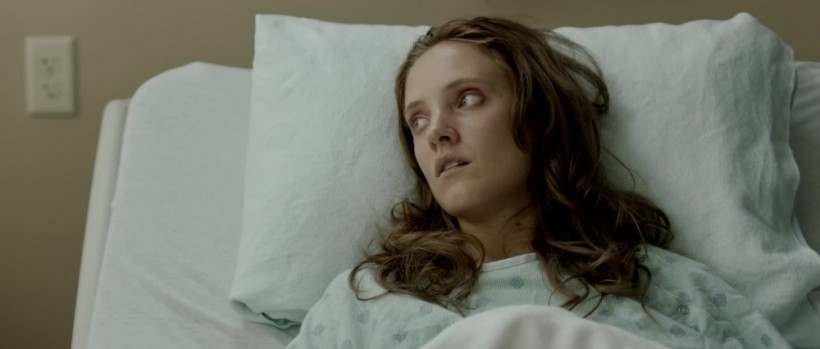
Proxy: Expecting Mother
The fact that there are so many more North American female-centered (and female-centric) horror films than ever before is an indication of at least two things: an increase in women horror spectators; and a reflection of gains made by women socially and in the film industry, which makes it possible now for men to fully identify, not ONLY with the Final Girl, but with the Primary Girl. Another indication of both these above points is what I refer to as female-centric horror films: films where either the manifestation of the horror, or the positive outcome that grows out of the struggle against the horrors, are things that are part of the female experience, and something a male spectator can sympathize with but never fully experience. For example, horror suffered by the female character that relates to menstruation (Ginger Snaps, Contracted) and pregnancy/birth. In many of these these female-centric films, Neighbor, Teeth, The Woman, All Cheerleaders Die, A Girl Walks Home Alone at Night, All the Boys Love Mandy Lane, and Dys-, the female characters go unpunished, which is a result of their acts of murder being justified within the narrative as a situation, if perhaps exaggerated, of real world experience: physical or mental abuse in the workforce, rape, and sexual harassment being the most common triggers for violence. The audience is meant to understand, if not condone or empathize with, the social, political, cultural or psychological pressures that have led the female character in question to commit these violent crimes. This is unlike male killers, whose justification is often pseudo-Freudian Mother-related trauma, and hence steers the discourse away from patriarchal models of meaning found in earlier North American horror films.
Women That Kill: Trending
Now that we have surveyed some of the key films and filmmakers that have challenged conventional representation of women as passive and/or victims in North American cinema, the question is why? Or why now? I will tentatively point to several possible reasons.
For starters, is the obvious influence of 1970s Euro horror on North American filmmakers, which is finally beginning to take root, helped by the increasing importance of International Film Festivals as a showcase and meeting place for like-minded filmmakers; and the explosion on DVD and Blu Ray of labels (Blue Underground, Anchor Bay, Raro Video, Shameless, Mondo Macabro, Arrow Video) specializing in European horror films of the 1960s, 1970s, which has made it much easier, and in some cases possible for the first time, to watch some of these films where women were commonly killers.
A second more internal and far ranging reason is the delayed impact of 1990s feminist scholarship on horror and gender (Carol Clover, Linda Williams, Barbara Creed, Robin Wood, Cynthia Freeland, Isabel Cristina Pinedo, etc.), which has spread beyond academia to practical filmmaking, film programming and the internet. Like niche websites and blogs charting female-made horror films, like Planet Etheria which has a Horror section with up to date female related horror news on new horror films, documentary, books, interviews, etc.. There is no doubt that feminist horror theory has come of age. Young independent academics and university trained female filmmakers, who have encountered these theories across their university degree, have become savvy about the value of injecting social and gender-political ideas in their films, and are trained with the scholarly background to do so, helping to generate festival interest and niche markets (for example, Women in Horror month). In some cases these young academics are entering into University departments and stamping these feminist theories and films into their curriculum. There are now festivals catering specifically to female-centric horror films (the now extinct Viscera Film Festival, Etheria Film Night), either featuring films made by women or for women. More women reading and writing about horror film also means more female horror spectators, which is another indirect reason why there are more female killers: knowing there are more women watching horror translates to better female roles. And recent spectator studies (Brigid Cherry, Aalya Ahmad, Amy Jane Vosper) have shown that women do like horror, even if women tend to have different aesthetic tastes in horror (psychological horror over gore, vampires over zombies).
Female writers continue to proliferate the world of professional horror magazines (Fangoria, Rue Morgue), fanzines (Cannibal Culture Magazine), and blogs, often ‘graduating’ to festival film programming (i.e. Jovanka Vuckovic, Kier-La Janisse). In Montreal we have a yearly horror festival called Spasms which includes several women in key roles; there is also a strong female presence behind the Montreal Underground Film festival which often features avant-garde and experimental horror. Figures like Heidi Honeycutt, Maude Richards, and Kier-La Janisse are examples of the sort of resourceful, enterprising “horror ambassador” that one often finds among the female horror community. Kier-La Janisse has done it all in the field of horror, gliding effortlessly between film programming, teaching, writing, publishing, and blogging, co-founder of Montreal microcinema Blue Sunshine (2010-2012) and founder of a study center for horror, The Miskatonic Institute of Horror Studies. Heidi Honeycutt is a film programmer, horror blogger, writer, and is currently working on a book charting the history of female horror directors. Maude Michaud is a writer, blogger and documentarist who has recently finished her first feature horror film Dys-.
Another important reason behind this increase in femme-horror is the impact of digital technology which has tended to demystify the technology of the cinema apparatus (for both men and women) and made it potentially cheaper to make films (I say potentially because the digital revolution has not led to budgets coming down for big budget Hollywood films). In her essay from last issue “Horror Grrrls: Feminist Horror Filmmakers and Agency” Maude Michaud compares the indie Women in Horror Movement to the 1990s Riot Grrrls underground punk movement, who used a DIY attitude, “grassroots promotion” and the benefits of internet technology in taking a more active role as makers as well as consumers of the music: like the Riot Grrrls movement, these younger academics, fans, and indie filmmakers want “to reach younger women and offer them horror films with feminine sensibilities that might encourage them to pick up a camera and create their own stories.”
And finally, as they say, the proof is in the pudding, and there has been a staggering increase in women in North America working behind the camera in production capacities (director, writer) in the horror genre since around 2000: Mary Harron (American Psycho, 2000, The Moth Diaries, 2011), Elza Kephart (Graveyard Alive 2003), Izabel Grondin Montreal-based horror short film auteur, Kimberly Peirce (Carrie, 2013), Axelle Carolyn (Soulmate, 2013), Karyn Kusama (Jennifer’s Body, 2007), Jennifer and Sylvia Soska (Dead Hooker in a Trunk, 2008, American Mary, 2012, See No Evil 2, 2014), Jennifer Lynch (Chained, 2012), Ana Lily Amirpour (A Girl Walks Home Alone at Night, 2014), Annette Ashlie Slomka (co-director of The Secret Life of Sarah Sheldon, 2006), Jovanka Vuckovic (The Captured Bird, The Guest), Karen Lam (Evangeline), Maude Michaud (Dys-, 2014), and Kate Robbins (Candy Stripers, 2006). There is clearly more work to be done before there is anything like gender parity in the film industry, but the horror genre, more than any other, is paving the way.
Bibliography
Gibert, Maxime Arthur. “B-Laboring the Point.”. Diabolique , Issue No. 22, Sept/October 2014, 56-59.
Janisse, Kier-La. The House of Psychotic Women. FAB Press, 2012.
C. Jerry Kutner, “American Mary (2012) and the Female-Centered Horror Film,” Bright Lights Film Journal, October 12, 2013.
Towlson, Jon. Subversive Horror Cinema. Mcfarland & Co Inc Pub, 2014.



